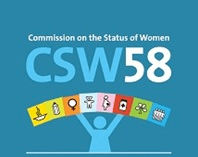The second week of the Commission on the Status of Women (CSW58) began yesterday here at UN Headquarters. The debate over a final outcome document from the conference — and how it will approach the post MDG international development agenda — is dominating discussions.
Currently, the Millennium Development Goals (MDGs) are the loose framework for these decisions, but the post-2015 framework is what is up for real debate now. One of the issues being discussed at CSW is actually a startlingly simple one: will the women’s rights and gender equality goal continue to receive at least the same visibility in the post-2015 framework as it does now in the MDGs?
As it stands, Goal 3 of the Millennium Development Goals is to “Promote gender equality and empower women.” Until September the Open Working Groups of the UN will meet to discuss what the different facets of the post-2015 framework and Sustainable Development Goals (SDGs) will look like, after which intergovernmental negotiations begin. The question that looms for women’s rights advocates is whether there will be an SDG solely devoted to gender equality that mirrors Goal 3, and whether or not gender equality will be woven into all the other goals.
UN Dispatch spoke to conference attendee Lee Webster, Head of Policy for Womankind, who says she can’t “even dare to imagine a post-2015 framework without a standalone goal on women’s rights and gender equality.” Anything less than an all-encompassing focus on gender equality and women’s rights would be, Webster says, “a massive drawback.”
It seems strange that the topic even needs to be up for discussion considering that there is a Goal 3, but Webster explains that many assume that “gender has been done” and that there will automatically be SDGs that mirror the MDGs. However, nothing is guaranteed with 180 member countries weighing in on every aspect of the post-2015 framework.
The crux of the push for a standalone goal seems to be a common problem with any development issue: resources and funding. As Webster says, “we talk about data as if it’s this really technical thing…but the decision about what gets measured and how, is inherently political because whatever we measure is where the money goes.” Despite what UN Women calls a “failure to address the structural causes of gender inequality” on the part of MDG3, it can be argued that women’s rights have come at least this far, with the formation of UN Women and at least a recognition of women’s rights in laws in many countries, because there was a recognition of it as a separate goal back when the MDGs were formed.
The push for a standalone goal is certainly a necessary one, but just as important should be making UN Women Director Mlambo-Ngucka’s statement from International Women’s Day a reality. She called for mainstreaming of gender equality into all facets of the UN and that should be reflected in the post-2015 framework. Webster calls for “gender experts on all funding boards and decision-making bodies” across the Intergovernmental Panels in order to assure gender equality consideration.
Whatever the outcome, it is likely that gender rights will have at least a stand-alone goal if not also being mainstreamed into other goals. Decisions made by the intergovernmental negotiations beginning in September will take this year’s CSW and any Open Working Group session documents into real consideration, hence the importance of a continued push for women’s rights for inclusion after 2015. It is clear from the discussions at CSW this year that the work for gender equality has come a long way, but member countries cannot assume the road ends here.
